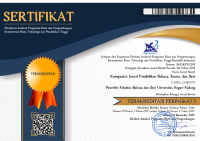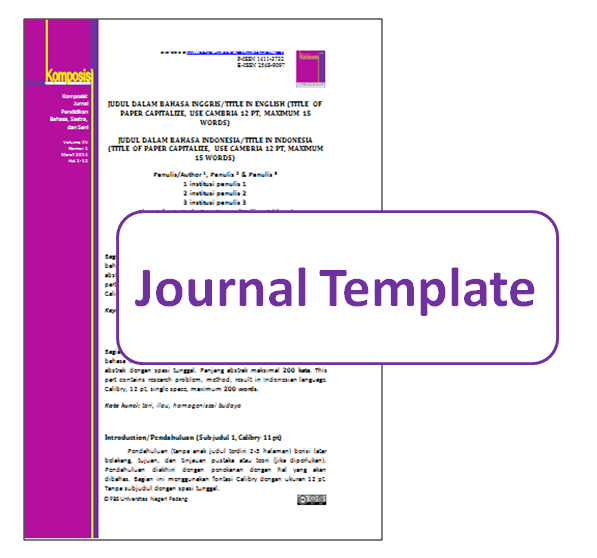Figurative Language in Rabab Pasisia Oral Literature and Its Implications on the Develompment of Figuratives of Speech Teaching Materials
 ),
), (1) Universitas Adzjua
 Corresponding Author
Corresponding Author
Copyright (c) 2024 Komposisi: Jurnal Pendidikan Bahasa, Sastra, dan Seni
DOI : https://doi.org/10.24036/komposisi.v25i1.127668
Full Text:
 Language : id
Language : id
Abstract
Figurative language is a form of language that is often used in oral literature. One example of oral literature that uses figurative language is Rabab Pasisia. Rabab Pasisia is a type of oral literature originating from Minangkabau, West Sumatera. This study aims to analyze the use of figurative language in the oral literature of Rabab Pasisia and its implications for the preparation of figurative language teaching materials. The method used is a qualitative analysis of textual data from the oral literature of Rabab Pasisia. The data were analyzed by identifying the types of figurative language used in the literature. The results of the study show that figurative language in Rabab Pasisia includes the use of figures of speech such as simile, personification, alliteration, ellipsis, hyperbole, antithesis, metaphor. The use of this figurative language gives aesthetic value to Rabab Pasisia's oral literature and makes it more lively and interesting. The implication of this research is that figurative language in Rabab Pasisia can be an interesting teaching material in teaching figurative language. Teaching materials about figure of speech can be arranged by paying attention to the use of figurative language in Rabab Pasisia. This can help students to understand the concept of figure of speech better and develop their creativity in using figurative language in their own literary works.
Keywords
References
Alkhammash, R. (2022). Processing figurative language: Evidence from native and non-native speakers of English. Frontiers in Psychology, 13(November), 1–13. https://doi.org/10.3389/fpsyg.2022.1057662
Bastan, M., & Lal, Y. K. (2022). SBU Figures It Out: Models Explain Figurative Language. FLP 2022 - 3rd Workshop on Figurative Language Processing, Proceedings of the Workshop, 2019, 143–149. https://doi.org/10.18653/v1/2022.flp-1.20
Chakrabarty, T., Choi, Y., & Shwartz, V. (2022). It’s not Rocket Science: Interpreting Figurative Language in Narratives. Transactions of the Association for Computational Linguistics, 10, 589–606. https://doi.org/10.1162/tacl a 00478
Dewi, D. A. M. D. K., & Putra, I. G. A. C. S. (2022). an Analysis of Figurative Language in the Song Lyric By Adele’S. BULLET: Jurnal Multidisiplin Ilmu, 1 (05)(5), 922–926.
Fajar Alamsyah. (2020). Pemakaian Majas Di Antologi Puisi Pada Ciptaan Sapardi Djoko Damono. Scolae: Journal of Pedagogy, 3(1), 19–26.
Fatmawati, N. E. (2020). Aspek Citraan dan Bahasa Figuratif pada Buku Antologi Puisi “Suluk Nang, Ning, Nung” Karya Handoko F. Zainsam. Diskursus: Jurnal Pendidikan Bahasa Indonesia, 2(01), 69. https://doi.org/10.30998/diskursus.v2i01.6665
Herianah, & Asis, A. (2021). Penggunaan Majas Dan Penyiasatan Struktur Dalam Sastra Lisan Toraja : Upaya Pelestarian Bahasa Daerah the Use of Figurative Language and the Structural Strategy in Torajan Oral Literatures : Efforts To Lacal Language. 12(1), 127–138.
José Ruiz de Mendoza Ibáñez, F., & Sandra Peña Cervel, M. (2023). Structural similarity in figurative language: A preliminary cognitive analysis. Lingua, 290. https://doi.org/10.1016/j.lingua.2023.103541
Karimah, D., Anggraeni, L., Hayuningtias, N. R., & Yunia, R. P. (2022). An Analysis Figurative Language in The Short Story “Tale - Tell Heart.” Lingua (2022), 19(1), 1–6. https://doi.org/10.30957/lingua.v19i1.694.An
Khalidi, S. N. M., & Yaakob, N. A. (2018). Bahasa Figuratif sebagai Wahana Penjelasan Unsur Emotif: Figurative Language as a Reflection of Emotive Elements. Journal of Management and Muamalah, 1–16. http://jmm.kuis.edu.my/index.php/jurnal/article/view/56%0Ahttp://jmm.kuis.edu.my/index.php/jurnal/article/download/56/40
Koller, S., Müller, N., & Kauschke, C. (2022). The Elephant in the Room: A Systematic Review of Stimulus Control in Neuro-Measurement Studies on Figurative Language Processing. Frontiers in Human Neuroscience, 15(January), 1–18. https://doi.org/10.3389/fnhum.2021.791374
Liu, E., Cui, C., Zheng, K., & Neubig, G. (2022). Testing the Ability of Language Models to Interpret Figurative Language. NAACL 2022 - 2022 Conference of the North American Chapter of the Association for Computational Linguistics: Human Language Technologies, Proceedings of the Conference, 1, 4437–4452. https://doi.org/10.18653/v1/2022.naacl-main.330
Magdalena, I., Sundari, T., Nurkamilah, S., Nasrullah, & Amalia, D. A. (2022). Analisis Bahan Ajar. Pendidikan Dan Ilmu Sosial, 2(2), 2022. https://ejournal.stitpn.ac.id/index.php/nusantara
Milana, H., & Ardi, H. (2020). E-Journal of English Language & Literature AN ANALYSIS OF FIGURATIVE LANGUAGE IN THE SONG LYRICS BY SAIF ADAM. E-Journal of English Language and Literature Volume 9 No.3, 9(3). http://ejournal.unp.ac.id/index.php/jell
Muflikhul, K. (2015). MAJAS DALAM KUMPULAN LIRIK LAGU BARASUARA (ANALISIS STILISTIKA) Kokoh. Block Caving – A Viable Alternative?, 21(1), 1–9.
Mulyono, T., & Triana, L. (2022). Aliterasi dan Asonansi pada Puisi Anak Indonesia Karya A. Hasjmy. Jurnal Pendidikan Dan Konseling, 4(5), 6467–6473.
Muziatun, Malabar, F., & Mitali, E. H. (2022). Figurative language in bruno mars lyrics. Indonesian EFL Journal (IEFLJ), 8(1), 63–72.
Ngangga Saputra, Alifiah Nurachmana, Hernika Anja Ratna Putri, Nani Sidarwati, & Selvia Sarcie. (2022). Majas Perulangan Dalam Buku Antologi Puisi Guru “Tentang Sebuah Buku Dan Rahasia Ilmu” Serta Implikasinya Pada Pembelajaran Sastra Di Sma. Prosiding Seminar Nasional Pendidikan, Bahasa, Sastra, Seni, Dan Budaya, 1(1), 60–74. https://doi.org/10.55606/mateandrau.v1i1.157
Ni Wayan Swarniti. (2022). Analysis of Figurative Language in “Easy On Me” Song Lyric. RETORIKA: Jurnal Ilmu Bahasa, 8(1), 13–18. https://doi.org/10.55637/jr.8.1.4708.13-18
Prihastuti, E., Nazaruddin, K., & Suyanto, E. (2013). Majas dalam Anak Ini Mau Mengencingi Jakarta? dan Kelayakannya Sebagai Bahan Ajar. NBER Working Papers, 89. http://www.nber.org/papers/w16019
Purati, S., & , Tri Mulyono, K. K. (2022). Prosiding Seminar Nasional Perisai Tahun 2022 PBSI FKIP UPS Tegal , 29 Juli 2022 Prosiding Seminar Nasional Perisai Tahun 2022 PBSI FKIP UPS Tegal , 29 Juli 2022 Karya sastra adalah sebuah ungkapan perasaan yang berasal dari dalam diri pengarang . Menurut.
Putri, E. A. R., Effendi, T., & Syafrudin, S. A. (2022). Figurative language in songs for English Learning. LADU: Journal of Languages and Education, 2(5), 157–167. https://doi.org/10.56724/ladu.v2i5.125
Reyes, A., & Saldívar, R. (2022). Figurative Language in Atypical Contexts: Searching for Creativity in Narco Language. Applied Sciences (Switzerland), 12(3). https://doi.org/10.3390/app12031642
Tini Mogea, & Salaki Reynaldo Joshua. (2022). Figurative Language as Reflected in Worthsworth’s Resolution and Independence. LITERACY : International Scientific Journals of Social, Education, Humanities, 1(2), 18–32. https://doi.org/10.56910/literacy.v1i2.208
Yono, R. R., Wulandari, S., & Budiana, N. (2022). Majas dan Citraan dalam Novel 29 Juz Harga Wanita Karya Ma’mun Affany Serta Implikasinya dalam Pembelajaran Sastra di SMA. Jurnal Kewarganegaraan, 6(3), 5090–5096. http://journal.upy.ac.id/index.php/pkn/article/view/3890
 Article Metrics
Article Metrics
 Abstract Views : 92 times
Abstract Views : 92 times
 PDF Downloaded : 40 times
PDF Downloaded : 40 times
Refbacks
- There are currently no refbacks.
Copyright (c) 2024 Komposisi: Jurnal Pendidikan Bahasa, Sastra, dan Seni

This work is licensed under a Creative Commons Attribution-NonCommercial 4.0 International License.











